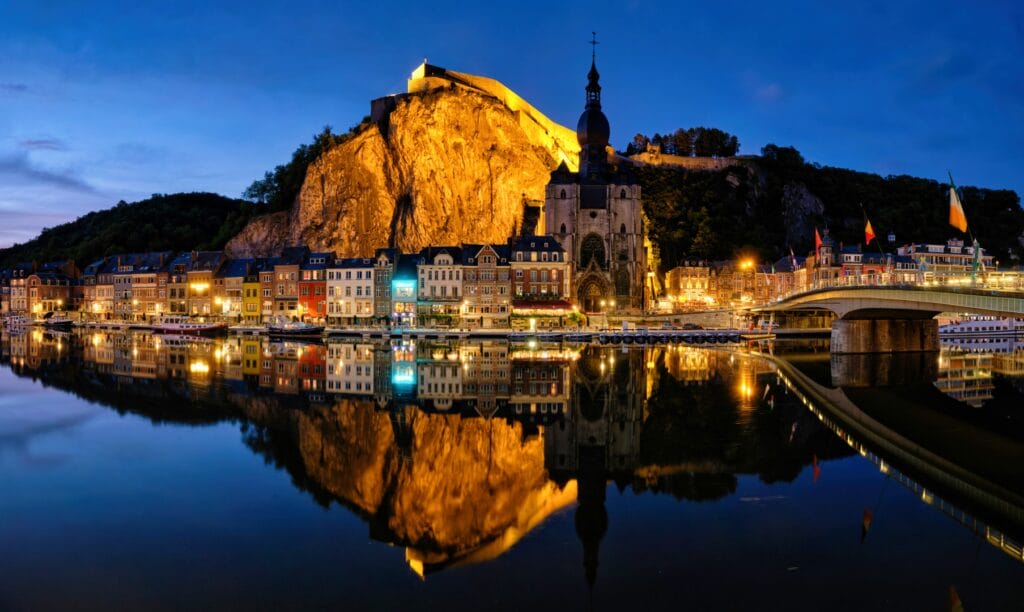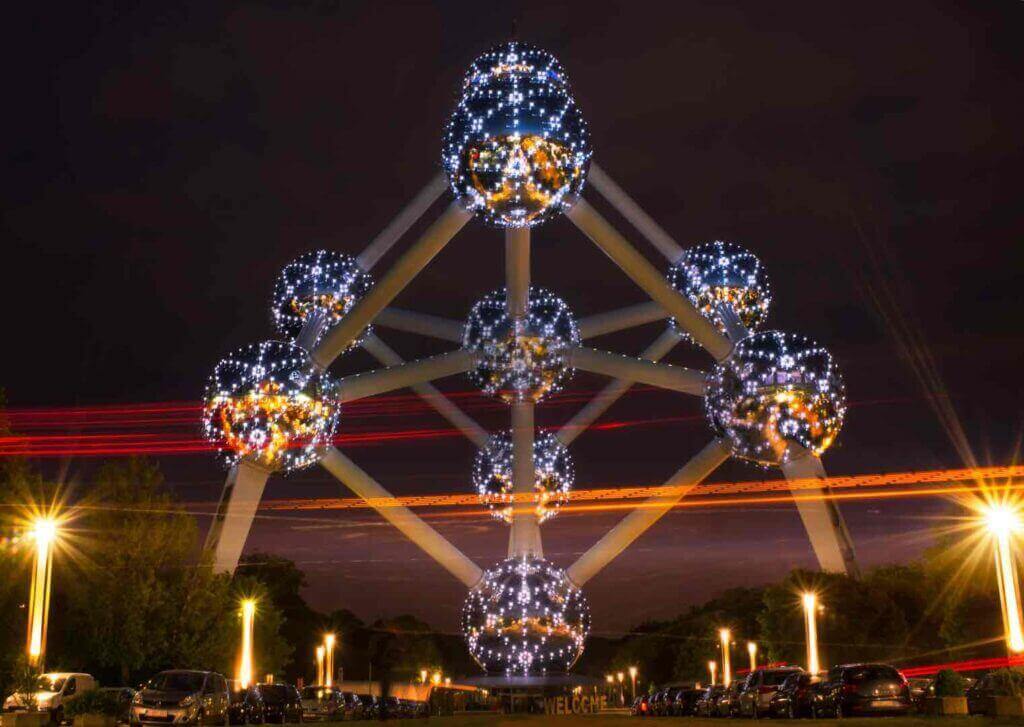Belgium Travel Guide
Internationally famed for its fine chocolates, beers and waffles, Belgium is a beautiful country populated with historic cities, medieval castles and impressive architecture. Nestled in between the Netherlands, Germany, Luxembourg and France, Belgium comprises two distinctive cultural regions, which are the Dutch-speaking Flanders in the North and the French-speaking Wallonia in the South. Flanders is home to many of the country’s vibrant cities whereas Wallonia contrastingly features rolling countryside, rural farms and forests.
At the heart of Belgium is its thriving capital city, Brussels, a cosmopolitan city rich in museums, dining, shopping, nightlife and fine art and architecture that is exemplified in the famous Grand Place and the remarkable palaces and churches such as the cathedrals of St. Michael and St. Gudula.
Belgium’s most popular destination, Bruges, enchants tourists with its romantic medieval town known for its Flemish art, 13th century belfry and lots of chocolate boutiques. And don’t forget the historic city of Ghent! 🇧🇪
Jump to...
ToggleBest Time To Visit

Because it’s a year-round destination, the best time to visit Belgium depends on your own personal tastes.
The country boasts warm summers (June to August) that aren’t too hot and are packed with cultural events and festivals. Those are the peak months for visitors, who come to enjoy the plentiful sunshine and take advantage of summer holidays taking place across Europe.
You’ll also find pleasant weather in the spring (April to May) and autumn (September to October) seasons, with mild days and cool nights. The crowds are much thinner than you’ll find in the summer and prices are lower.
There’s also a plenty of Christmas festivities you can enjoy in November and December, as well as Carnival in February and March. The winter months are generally quieter and offer great value, though Christmas markets and Carnival do cause a sharp increase in crowds.
What To Expect
Capital: Brussels
Language: Belgium has three official languages, Flemish (Dutch), French, and German. You’ll often see signs in both French and Flemish.
Currency: The official currency of Belgium is the Euro (EUR). $1 USD is equivalent to 1.09 EUR and £1 is 0.82 euro. Check the latest rates here
Credit Cards & ATMs: You shouldn’t have any trouble using your credit card when visiting Belgium. However, keep in mind that many people prefer cash when it comes to small purchases. There are ATMs in all Belgian cities and towns, and you’ll usually find them near gas stations, shopping centres, and bus and train stations. Most places also accept Google Pay and Apple Pay.
Plugs: Power plugs are type E, the standard voltage is 230 V, and the standard frequency is 50 Hz. I recommend buying a universal adapter as they make everything so much easier.
Safety: Belgium is a safe country to visit. Petty crime does exist as in most countries, so don’t carry too much cash and keep an eye on your bags.
Useful tip: Eat local – By eating at restaurants serving traditional cuisine, you’ll keep your food expenses low.
Never ever: 1. Don’t Trust the Crosswalks. Unless you’re trying to cross the street at a spot that’s governed by a traffic light or sign. 2. Don’t TIP, its already on your bill.
Travel Guides
Below you will find guides on places in Belgium, including best things to see and do, itineraries etc.
City Guides
Itineraries + Map
Best Places to Visit & Things to Do
Best Time to Visit (City Specific)
Belgium Travel Tips and Advice
Everything Else
Search for your Accommodation
Find the Cheapest Flights
Book tours and purchase tickets
Top 5 Things to See and Do in Brussels
1. Relishing Chocolates in Brussels
When one thinks of Belgium, the delightful allure of chocolates immediately springs to mind. Brussels, the country’s capital, is the epicentre of this chocolaty indulgence. Popping into any of the city’s countless artisanal chocolate boutiques, like Neuhaus or Godiva, visitors can watch chocolatiers craft intricate confections and, of course, sample these delectable treats. Chocolate-tasting tours guide enthusiasts through a journey of flavours, from pralines to truffles, ensuring a sweet immersion into Belgium’s proud cocoa heritage.
2. Strolling Through Bruges' Medieval Heart
Often likened to a page from a fairy tale, Bruges is a mesmerising blend of Gothic spires, winding canals, and cobbled lanes. The city’s historic centre, a UNESCO World Heritage site, is best explored on foot or by a tranquil boat ride on its canals. Iconic spots include the Markt Square, dominated by the towering Belfry, and the serene Begijnhof, a secluded courtyard once home to a religious community of women. As the day fades, the medieval charm is accentuated under the soft glow of street lamps, making Bruges a romantic retreat.
3. Experiencing the Battlefields of Ypres
Salzburg, the birthplace of Mozart, is not just steeped in musical heritage but also offers a harmonious blend of baroque architecture and alpine landscapes. Every summer, the city plays host to the Salzburg Festival, a world-renowned event celebrating opera, theatre, and classical concerts. Visitors can revel in top-tier performances set against the backdrop of historic venues, from the grand Felsenreitschule theatre to the intimate surrounds of the Mozarteum. The magic of music further intertwines with the city’s elegance as the melodies of Mozart and other legends waft through the streets.
4. Sipping Beers in an Abbey Brewery
Belgian beers, with their rich flavours and diverse styles, are a source of national pride. The country boasts several Trappist breweries, where monks have been perfecting the art of brewing for centuries. A visit to one of these abbeys, such as Chimay or Orval, promises more than just a tasting session. The serene surroundings, combined with the monastic traditions, provide a unique backdrop for understanding the intricate brewing processes. Paired with some local cheese, the experience becomes a gastronomic delight, celebrating the best of Belgian flavours.
5. MarveLling at Antwerp's Diamond District
Antwerp, often termed the ‘Diamond Capital of the World’, has been at the forefront of the diamond trade for over five centuries. The city’s Diamond District is a bustling enclave of traders, craftsmen, and merchants. Window shopping here is a glittering affair, with countless jewellers showcasing exquisite gem-studded creations. For those keen on delving deeper, the DIVA Antwerp Home of Diamonds offers interactive exhibits detailing the journey of diamonds, from their raw state to the sparkling jewels. Whether you’re in the market for a purchase or simply curious, Antwerp’s shimmering allure is undeniable.
Belgium Travel Costs
Accommodation
- Hostel Dorms – €25–€45 / £22–39 / $27–49
- Hostel Private Rooms – €70–€120 / £61–104 / $77–132
- Budget Hotels – €80–€140 / £70–121 / $88–154
- Airbnb Private Rooms – €50–€100 / £43–87 / $55–110
- Airbnb Apartments – €100–€200+ / £87–174+ / $110–220+
- Campsites – €15–€35 / £13–30 / $16–38
Transportation
- Local Bus, Tram, or Metro – €2–€2.50 per ride / £1.75–2.20 / $2.20–2.75
- Intercity Train – €15–€35 (depending on distance) / £13–30 / $16.50–38
- Taxi (per km) – €2.50–€3 / £2.20–2.60 / $2.75–3.30
- Car Rental (per day) – €40–€80 / £35–70 / $44–88
Food
- Budget Meal – €8–€15 / £7–13 / $9–16.50
- Mid-Range Restaurant Meal – €20–€35 / £17–30 / $22–38
- Coffee – €2–€4 / £1.75–3.50 / $2.20–4.40
- Beer – €4–€6 / £3.50–5.20 / $4.40–6.6
Activities
- Museum Entry – €8–€15 / £7–13 / $9–16.50
- Guided Tours – €25–€50 / £22–43 / $27–55
- Beer Tours – €30–€70 / £26–61 / $33–77
- Canal Cruises (in Bruges or Ghent) – €10–€20 / £9–17 / $11–22
Belgium Suggested Budgets
Backpacker – €50 Per Day
(Approx. £43 / $55)
A backpacking budget allows you to stay in a hostel dorm, cook some of your meals, and use Belgium’s extensive public transport system, such as buses, trams, and trains. You can enjoy free or low-cost activities like exploring historic city centres, parks, or attending free walking tours.
If you plan to drink Belgium’s famous beers, add an extra €5–€10 / £4–9 / $5.50–11 per day for alcohol expenses. Shopping at local supermarkets for groceries will also help stretch your budget.
Midrange – €120 Per Day
(Approx. £104 / $132)
A mid-range budget offers you the comfort of staying in a private room at a hostel, budget hotel, or Airbnb. This budget allows for dining out at mid-range restaurants, enjoying Belgium’s iconic dishes like mussels and fries, and indulging in a few drinks at local pubs or bars.
You’ll have the flexibility to visit museums and landmarks, take guided tours, and use intercity trains for day trips to cities like Bruges, Ghent, or Antwerp.
Upscale – €250+ Per Day
(Approx. £217+ / $275+)
A luxury budget ensures a stay in boutique hotels, high-end Airbnbs, or even historic properties. You can enjoy fine dining experiences, sampling Belgium’s gourmet cuisine and craft beers, while exploring the country through private tours or exclusive activities like chocolate-making workshops or luxury canal cruises in Bruges.
This budget covers first-class train tickets or private transfers for seamless transportation, allowing you to explore all the highlights of Belgium in comfort and style.
Belgium Money-Saving Tips
Belgium is not the cheapest destination in Europe, but with smart planning, you can enjoy its charm without breaking the bank. Here are some updated tips to help you save money during your trip:
Bring a Reusable Water Bottle – Belgium’s tap water is safe to drink, so bring a reusable water bottle to refill throughout the day. This will save you money and reduce plastic waste, especially when visiting cities with plenty of public fountains.
Take Free Walking Tours – Many cities in Belgium, such as Brussels, Bruges, and Ghent, offer free walking tours that provide great insights into local history and culture. Be sure to tip your guide €5–€10 for their time and knowledge.
Cook Your Own Meals – Hostels, Airbnbs, and some budget accommodations often come with kitchen facilities. Shop at local markets or supermarkets like Colruyt or Delhaize to prepare affordable meals. Belgian waffles, bread, and cheese are delicious and inexpensive options.
Stay in Hostels or Budget Hotels – Belgium offers a range of budget-friendly accommodations. Staying in hostels or booking budget hotels outside the city centre can significantly reduce your costs. Hostels often have social events or group tours that are either free or low-cost.
Use Public Transport – Belgium’s public transportation is efficient and affordable. Purchase a 10-ride pass or day pass for buses, trams, or metro systems in cities like Brussels and Antwerp. For intercity travel, book SNCB train tickets in advance to secure lower fares.
Take Advantage of Free Attractions – Belgium offers many free attractions, such as exploring historic city squares like Grand Place in Brussels, walking along Bruges’ canals, or hiking in the Ardennes Forest. Churches and cathedrals often have free entry, though some may charge for specific exhibits.
Visit During Off-Peak Times – Travel during the shoulder seasons (March–May or September–November) to benefit from cheaper accommodations and fewer crowds. Winter, outside the Christmas market season, can also offer good deals.
Skip the Taxis – Avoid taxis unless necessary, as they can be expensive. Instead, use public transport or rent a bike, especially in cities like Bruges or Ghent, which are bike-friendly and compact.
Try Local Food at Affordable Spots – Skip touristy restaurants in favour of local favourites. Many places offer lunch specials or prix fixe menus that include traditional Belgian dishes like mussels and fries at a lower cost. Fritkots (chip shops) are a great way to enjoy a budget-friendly meal.
Use Discount Cards – Cities like Brussels and Antwerp offer tourist passes that include free or discounted entry to attractions, free public transport, and other perks. The Brussels Card or Antwerp City Card can save you money if you plan to visit multiple sites.
Cycle to Explore – Rent a bike for around €10–€15 per day and explore cities or nearby countryside at your own pace. Belgium’s flat terrain and dedicated cycling paths make it ideal for budget-friendly exploration.
How to Get Around in Belgium
Getting around Belgium is convenient and efficient, thanks to its excellent infrastructure and compact size. Here’s an updated guide to navigating the country affordably and easily:
Walking
Belgium’s cities, such as Brussels, Bruges, and Ghent, are compact and pedestrian-friendly, making walking the easiest and most enjoyable way to explore city centres and historic areas.
Public Transportation
Belgium has a reliable and efficient public transport system in cities and for intercity travel. Trams, buses, and metro services are operated by STIB/MIVB in Brussels, De Lijn in Flanders, and TEC in Wallonia.
- Single-ride tickets cost around €2.50–€3 / £2.15–£2.60 / $2.75–$3.30.
- Day passes are available for €8–€10 / £7–£8.70 / $8.80–$11, ideal for tourists exploring multiple sites.
Airport Transfers
From Brussels Airport, the train to the city centre is the fastest and most affordable option, costing around €10–€12 / £8.70–£10.50 / $11–$13.50, with a travel time of 15–20 minutes.
Buses and airport shuttles are also available, costing €5–€10 / £4.30–£8.70 / $5.50–$11. Taxis from the airport to central Brussels cost approximately €50–€60 / £43–£52 / $55–$66.
We recommend Welcome Pickups for airport transfers in Belgium.
Taxis
Taxis are widely available but can be expensive. Fares start at around €3–€4 / £2.60–£3.45 / $3.30–$4.40, with an additional cost of €2 per kilometre / £1.75 / $2.20. Ride-hailing apps like Bolt or Uber are available in major cities and often provide cheaper alternatives.
Trains
Belgium’s train network is extensive and operated by SNCB/NMBS, making intercity travel quick and easy.
- Brussels to Bruges: ~€15–€20 / £13–£17 / $16.50–$22, 1 hour
- Brussels to Ghent: ~€10–€15 / £8.70–£13 / $11–$16.50, 30 minutes
- Brussels to Antwerp: ~€9–€14 / £7.80–£12.20 / $10–$15.50, 45 minutes
Discounted tickets are available for those under 26 (Go Pass) or over 65, and booking in advance can save you money.
Buses and Coaches
Long-distance buses, operated by companies like FlixBus, are an economical way to travel between Belgian cities and neighbouring countries. Fares typically range from €5–€20 / £4.30–£17 / $5.50–$22. Use BusBud for the best fairs.
Car Rental
Renting a car is a good option for exploring Belgium’s countryside or small towns like Dinant and the Ardennes. Rentals start at around €40–€80 per day / £35–£70 / $44–$88. You’ll need a valid EU driving licence or an International Driving Permit (IDP). Use DiscoverCars to find your car rental.
Cycling
Belgium is highly bike-friendly, with well-maintained cycling paths in cities and rural areas. Bike rentals cost around €10–€20 per day / £8.70–£17 / $11–$22. Explore Bruges, Ghent, or scenic routes like the Scheldt River Path on two wheels.
Tips for Getting Around
- Use Travel Passes: City-specific passes like the Brussels Card or train passes like the Rail Pass (10 journeys for €87) can save you money if travelling extensively.
- Avoid Taxis: Opt for public transport or bike rentals, as taxis are costly and less efficient.
- Plan Ahead: Booking train tickets early often secures discounted fares, especially for longer routes.
Travel Resources
Get Your Free Travel Starter Kit!

Like, follow, subscribe...
*Disclosure: Please note that some of the links above may be affiliate links, and at no additional cost to you, I earn a commission if you make a purchase. I only recommend products and companies I use and the income goes to keeping the site community supported.



























